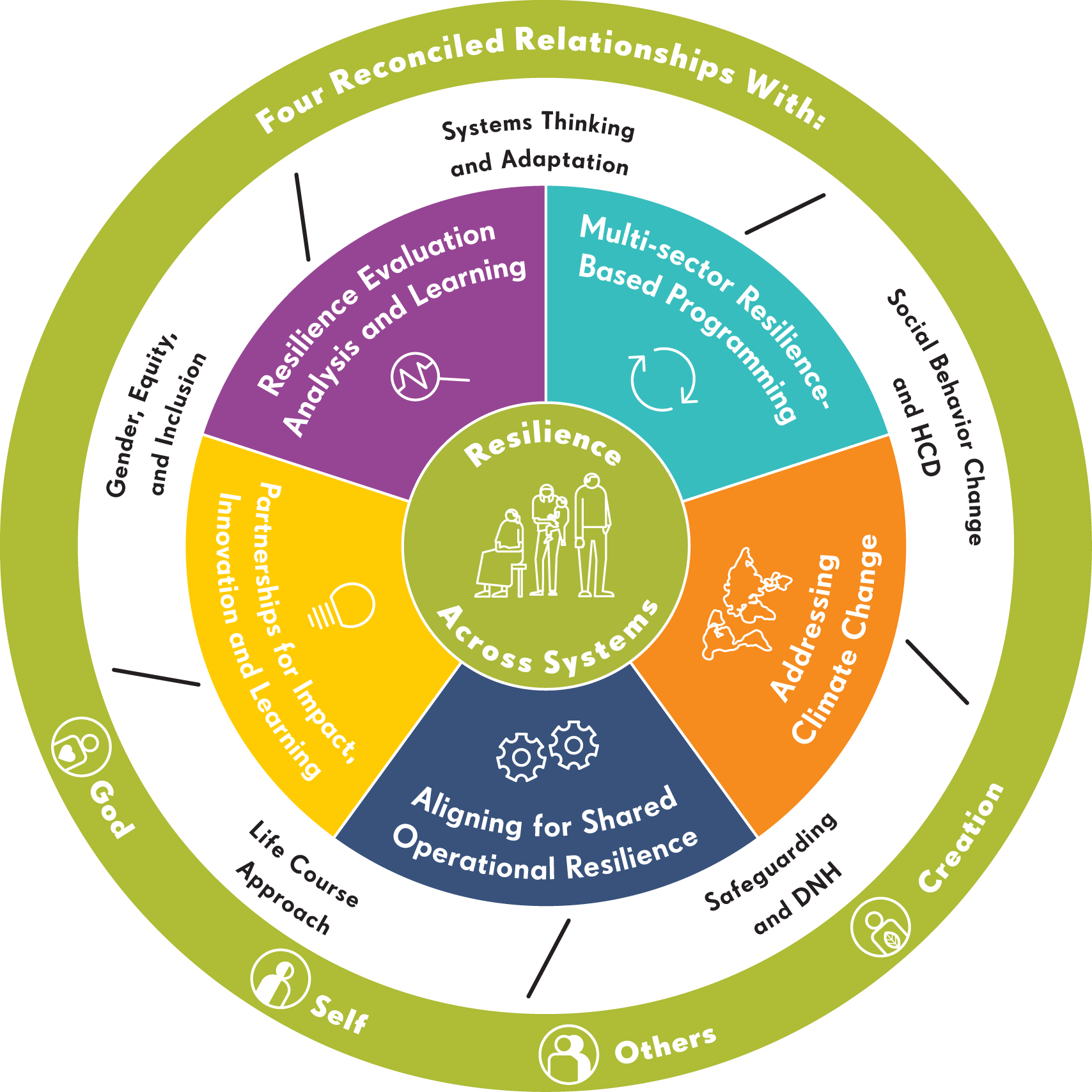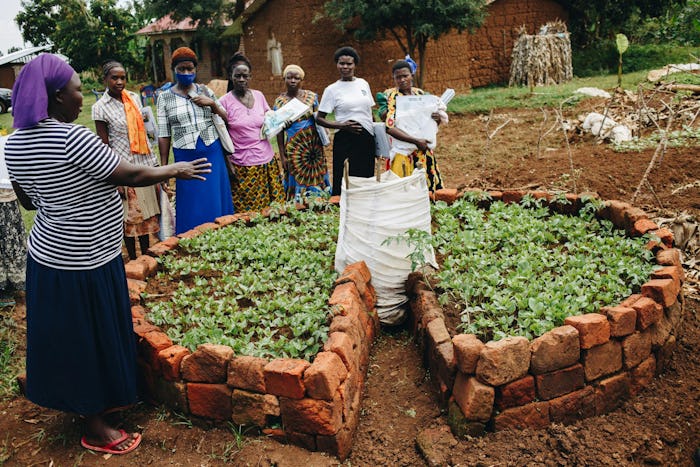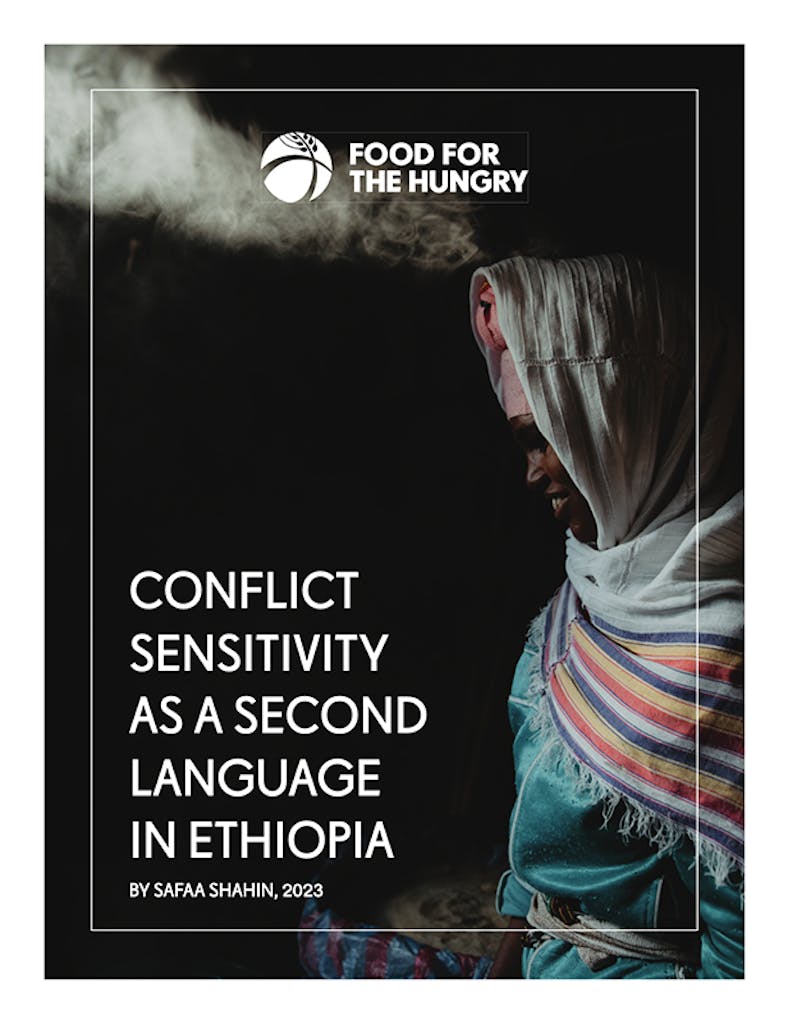Resilience
A new approach to eradicating extreme poverty
The world has made great advances in reducing poverty over the past few decades, but it is becoming more difficult to reach the most vulnerable in the hardest places (fragile contexts), which have become the center of the global development crisis. Overlapping crises of the pandemic, climate change and disasters, inflation, conflict, and global food insecurity are having the greatest impact on the most vulnerable people in the hardest places.
These challenges call for a new approach to eradicating extreme poverty. Conventional development has focused on meeting short- and long-term needs. What is missing is a focus on identifying complex risks of shocks (like cyclones and epidemics) and stressors (like chronic unemployment and forced displacement) that disrupt development agendas and peoples’ lives and livelihoods, and then fostering resilient solutions.
Food for the Hungry has made resilience a central focus of its work with vulnerable communities in fragile contexts, taking an overarching “shared resilience approach.”
What drives resilience?
Since fragility is an imbalance of higher risks and lower capacities to manage those risks within fragile settings, international efforts must work with societies and governments to foster a range of resilient and positive coping capacities to better absorb shocks and stress, adapt in the face of crises, and to transform formal systems and institutions to get to the root causes of risks and crises that cause extreme poverty.
A core driver of resilience building is what we call social capital, which involves “bonding” within communities, “bridging” across communities, and “linking” between communities and formal institutions and systems for access to information, resources, and responsive action. Social capital helps to better mitigate risks and cope with shocks and stressors.
Test your resilience knowledge!
Social capital is a core driver of resilience. What are the three types of social capital?
Current development approaches focus on meeting human needs, but to build resilience, what do we also need to focus on?
Resilience Approach
Food for the Hungry works through a resilience approach that supports positive relationships and connections between communities, markets, governments, systems and institutions to raise the overall resilience of vulnerable people and groups across systems in the hardest places. Striving for resilience guides our work across multiple sectors/themes (food security, markets, health, WASH, nutrition, education, disaster response, behavioral change, gender, equity and inclusion) and scales (national, regional, community, household, individual) to support the most vulnerable communities. FH’s approach has six components:
- Fostering resilient systems by mapping overlapping risks and crises across social, economic and environmental systems, and strengthening resilience capacities and social capital among vulnerable households, between communities and in connecting with actors across local and national levels
- Strengthening resilience through risk informed programs to foster absorptive, adaptive and transformative capacities
- Conducting resilience evaluation, analysis and learning (REAL)
- Addressing climate change through climate change adaptation projects, advocacy and efforts to reduce our own carbon footprint
- Cultivating partnerships for impact, learning and innovation
- Striving for operational resilience in the face of adverse conditions
FH’s resilience approach puts a major emphasis on strengthening social capital (bonding, bridging and linking) as the driver of resilience and the core element of resilience processes and outcomes.

2023 Concordia Annual Summit: Regenerative Agriculture, Food Security and Nutrition
This session explores the symbiotic relationship between regenerative agriculture and food security, understanding how regenerative practices play a pivotal role in maintaining soil health, promoting biodiversity, and reducing the ecological footprint of agriculture, while exploring the critical question of how to ensure adequate nutrition for a growing global population without compromising the planet’s resources.
Food for the Hungry is a Christian relief and development organization with a vision to see all forms of human poverty ended worldwide. We believe that when a community is equipped to care for its most vulnerable members, everyone is served, and poverty is eliminated. That’s why we seek to develop communities by focusing on children. Sponsor a child today and set them on a path to a better future: https://www.fh.org/give/sponsor-a-child/
Country-Level Resilience
Ethiopia
Developing a conflict-sensitive approach must inform organizations’ decision-making processes to ensure that their assistance effectively addresses people’s needs and contributes positively to their dignity and safety. This guidance document is FH’s contribution to international development, humanitarian assistance, and peacebuilding in Ethiopia.
FH has developed this practical guidance drawing on experience and expertise in conflict-sensitive programming, promoting best
practices that are conflict sensitive, and addressing complex challenges faced by vulnerable populations in Ethiopia and beyond.
Guatemala
FH works to empower indigenous women in Guatemala by strengthening their resilience capacities to absorb and recover from the compounding negative impacts of climate change, COVID-19, and other crises. Indigenous women in remote rural communities are highly vulnerable due to social exclusion of indigenous peoples, COVID -19, inflation, climate change—which has a multiplier effect that increases social, political, and economic tensions—and gender inequality, all of which perpetuate the cycle of poverty and exclusion. FH implements this work in partnership with indigenous women and girls, government, bilateral and multilateral institutions, private sector, and civil society. Building upon evidence from research and assessments, FH is targeting key risks, threats, and stressors faced by indigenous women and girls in rural areas of Guatemala, has identified their formal and informal capacities, and supports them to have a wide impact on their communities and society.
Uganda
Even before global crises of COVID-19, worsening climate change, economic shocks, and increasing conflicts, Karamoja was one of Uganda’s most fragile regions. The area experiences drought, hunger, disasters, instability, marginalization, disease outbreaks, price shocks, and extreme poverty. Now, these global crises are contributing to new and complex patterns of economic volatility, food insecurity, forced displacement, and mounting local tensions in the region. Food for the Hungry, Office of the Prime Minister, and the Karamoja Resilience Secretariat discussed the region’s changing risk landscape and explored opportunities for strengthening the often overlooked but vital resilience capacities within communities, institutions, markets, and social systems to weather mounting risks and protracted crises.
Resources
Resilience for US policy and resource allocation:
Brookings:From fragility to resilience: Recommendations for implementing the US global fragility strategy
Resilient Statebuilding
OECD: Resilient state-building: A new approach for the hardest places
Columbia: Revisiting Statebuilding in the Hardest Places
World Bank Fragility Forum: Adaptive Management in Fragile Contexts: Navigating Uncertainty in Hard Places
Country Platforms
World Bank: Country platforms in fragile states: A new path for development cooperation
Anti-corruption approaches for resilience in fragile contexts
ACE SOAS Consortium: From Fragility to Resilience: SOAS-ACE’s contribution to an emerging paradigm SOAS Consortium

“Making good on the global promise to leave no one behind depends on addressing the root causes of current and emerging crises, preventing their re-occurrence, and strengthening the resilience of those most vulnerable.”
–United Nations


